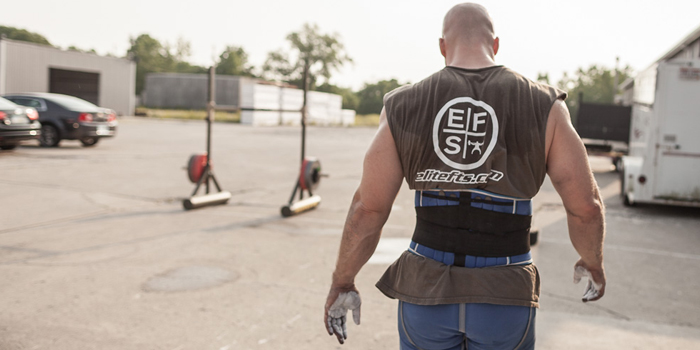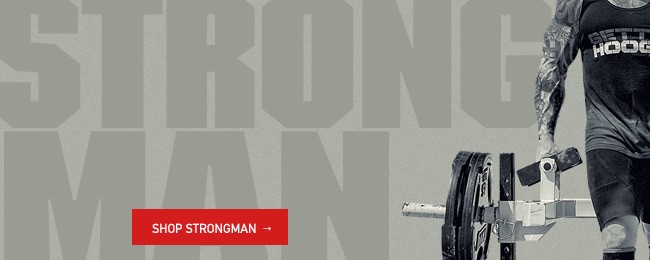
We all have weaknesses. Some have more than others, but in general, I usually see three major weaknesses when it comes to the overhead press: rack position, leg drive, and a weak lower back. These three weaknesses will severely mitigate any potential strength and power you could be throwing into your overhead press. Fortunately, I have a few unconventional movements to help fix these issues.
Front-Loaded High Squats to a Box
I learned about these from World’s Strongest Man competitor, the late Mike Jenkins. When he was getting ready for World’s Strongest Man a few years ago, his overhead press skyrocketed. I asked him what he was doing to get it up so high and he told me this was one of the keys to his improvement. I really like these because, if properly set up and executed, you can overload the rack position and work on a solid dip pattern in a safe and effective manner. An issue a lot of people have when it comes to a big push press is not only maintaining a solid rack position so there is no downward momentum from whichever implement they’re using, but also a lot of people have a tendency to struggle with maintaining a neutral hip position and put too much of the load into their quads. This can lead to a lot of complications down the road, like a torn quad.
RECENT: The Sumo Deadlift for Strongman
Setting up a high box right to the position of where your upward leg drive should start helps create a situation where you can load the glutes and hamstrings more efficiently, while also saving your knees and maintaining that neutral hip position. Overloading the rack position will also help create confidence with heavier weight when it comes time for competition. Personally, I know whether or not I’m going to press a weight the second I get it into a rack position from the clean. To set up, you’re going to have to find where the lowest point in your leg drive is. Next, set the box height to that position. Remember, this isn’t a high box squat; it’s a high squat to a box, so some forward tracking with your knees is okay. We’re not trying to take the quads out of the equation, but rather trying to add more glutes and hamstrings into it. Finally, you’re going to set whichever implement you’re using on pins and initiate from the bottom up, like in an Anderson squat.
Since you’re overloading the movement, you’re going to want to work with around 105% to 110% of your overhead max for no more than three to five reps for three to five sets. I like these as a secondary exercise on a squat day because you’ve already pre-exhausted your legs, so the weight, in theory, shouldn't come close to your squat working weight.
Hyperextension Overhead Press
I was hesitant to include this one in the article because we never want to be in hyperextension, right? Wrong. When a strongman competitor starts getting into super heavy overhead weights, having not only a strong but also mobile lower back and erectors will oftentimes make or break a press. This became apparent to me when I started creeping up toward the 400-pound overhead mark on both the axle and the log. #humblebrag. When you initiate a push press with that sort of weight (i.e. downward motion), that weight is going to want to do what gravity tells it to do: crush you until you’re dead. While having strong abs will help mitigate those effects, having a strong lower back will be key in keeping you alive. I’ve found out the hard way more than a few times just how important strong erectors are.
For setup, all you’re going to have to do is set a weight up in a rack. I like to do these with pins in a power rack because with this setup if I do lose the weight behind me, I can just dump it on the pins and bail out quickly. Another note is that you’ll need to set the pins a tad bit lower than you normally would. Once you’re set up, you’re going to get under the bar with your back hyperextended. As you initiate the press, you’re going to drive into an upward position (see the video above). Keep the reps very strict and don’t use too heavy of a load. I recommend these for higher reps with lower intensity as an accessory movement after a heavy overhead training session.
Concentric Power Jerk from Blocks
Continuing with the trend of building leg drive while maintaining a solid rack position, these fit in perfectly. I really like these to develop pressing power and leg drive. To me, these are a logical progression from the front-loaded high box squats because we are going to start in the same bottom position, but without the support of the box and with the addition of a press. However, this will not be an overload exercise. I would use only around 65% to 75% of your overhead training max for these and keep reps low.
Setup for these is simple and easy. We’re going to set the box and bar height low enough that when you rack the bar, you’re in the bottom position of your leg drive. You can do these from pins, but like pin pulls in the deadlift, this can be a little more taxing since you don’t get to reap the benefits of the bar bend as you’re driving force upward. Once you’re in the bottom rack position, as you drive up with your legs you’re also going to press the weight overhead. This exercise helps to teach force development and how to transfer that force from your legs into your press. Check out the video above for execution.
Hopefully, these can help shore up some of the weaknesses you may be seeing in your overhead. I wouldn’t dive right into using all three in your programming, but rather break down your overhead, see where your weaknesses are, and apply these as necessary. A big overhead is such an essential part of strongman, so I hope these help!










